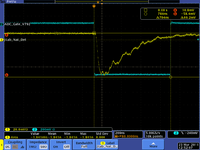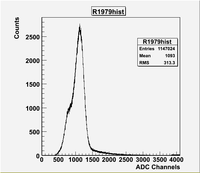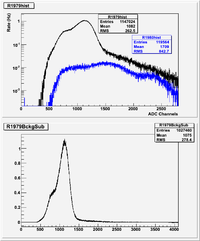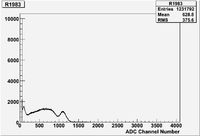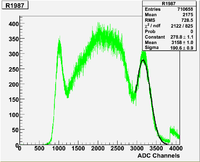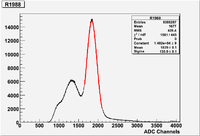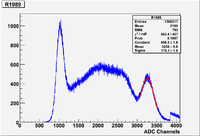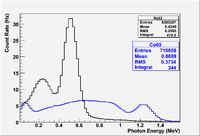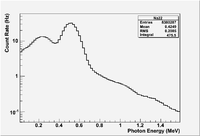Difference between revisions of "PePPO NaI PositronDetector 4 JLab"
| Line 379: | Line 379: | ||
Elapsed Time: seconds | Elapsed Time: seconds | ||
| + | |||
| + | |||
| + | ;Channe = -540.15 + 1279.2 HeV | ||
==Linearity== | ==Linearity== | ||
Revision as of 21:58, 25 March 2011
Detector setup for a NaI positron detector for PePPO
NaI detector
The PMT is powered by a HV supply which should have a DC ripple less than 200 mV peak-to-peak at 3kV/3mA. A DC ripple will change the gain of the PMT and cause the energy resolution to deteriorate.
The Linearity of the detector system is another way to reduce the energy resolution. The measured PMT output should be linear with the input signal when the gain is constant. This linearity can be measured using 2 radiation sources.
Input HV: +1085 V
Input Current: 2.362 mA
Running CODA: Running CODA
Measurements Using V792 QDC
Run 1979
Start Time : March 23:12:30:26
End Time: March 23: 13:10:47
Elapsed time: 2421 seconds
Run 1980
Remove Na-22 source from top of NaI crystal.
Start Time : March 23:13:11:23
End Time: March 23: 15:56:40
Elapsed Time:6317 seconds
Let's lower the gain of the Phillips 777 amplifier so the 511 peak is around channel 500. This way the 1 MeV photons may come on scale.
Run 1982
Overnight Cosmic Run
Start Time : March 23: 16:01:47
End Time: March 24: 09:41:31
Elapsed Time:63558 seconds
Run 1983
Start a run using Co-60
Start Time : March 24: 09:46:25
End Time: March 24: 10:14:24
Elapsed Time: 1679 seconds
The 1.x MeV gammas appear near channel 1200.
I'll do a long Na-22 run and think about upping the amplifier gain again to put the Co-60 peak around channel 3000.
The Co-60 source trigger rate is about 750 Hz and the Na-22 trigger rate was about 450 Hz.
Run 1984
Start a run using Na-22
Start Time : March 24: 10:16:49
End Time: March 24: 11:02:38
Elapsed Time: seconds
Run 1987
Increase gain of Phillips 777 amplifier which I am using on the PMT output, We may want to adjust the dynode gain/discriminator to fill in the lower energy part of the spectrum.
Start a run using Na-22
Start Time : March 24: 11:34:35
End Time: March 24: 1 Elapsed Time: seconds
I was expecting to see a photon of energy 1.17 and one with 1.33 MeV in the above specturm. Assuming that my ability to resolve the two peaks is due to noise I will assume both are in the peak at channel . Since the intensity of the above two lines are almost the same I will do a simple average.
- MeV
The above measurement indicates that a 1.25 MeV photon appears at channel in the current apparatus.
Run 1988
Start a run using Na-22
Start Time : March 24: 11:34:35
End Time: March 24: 16:21:31
Elapsed Time: 17216 seconds
The above measurement indicates that a 0.511 MeV photon appears at channel in the current apparatus.
Run 1989
Start a run using Co-60
Start Time : March 24: 16:23:30
End Time: March 24: 16:57:00
Elapsed Time: 2010 seconds
The above measurement indicates that a 1.25 MeV photon appears at channel previously it was at in the current apparatus.
The 98 channel difference is beyond the fit statistic.
Taking the average of the two give 3207 Channels.
Energy Calibration using run 1987-1989
Summary of Apparatus Specs
JLab PMT at +1185 Volts, 2.6 mA.
Dynode is inverted by Ortec 474 timing filter amplifier set to unity gain. The Ortec output is put through a Lecroy Model 4608C discriminator set to -44.8 mV.
Anode is amplified by a Phillips 777 fast Amp. Gained measured to be XXXXX
Doing a Linear fit using the two points
1.25 MeV ,3207 Channels
0.511 MeV , 1839 Channles
gives
Channels = 893.06 + 1851.2 MeV
The energy distributions measured do not appear to have the expected structure. There is a 1.3 MeV energy gamma from the Na-22 source which was expected but only hinted at. Its intensity is 10% but it should start to show up on long runs.
The next goal will be to lower the dynode discriminator threshold so we trigger on lower energy events. Does the Compton edge become more obvious for Na-22?
I think my trigger threshold on the dynode is cutting things off at 200 keV.
Run 1990
Overnight Cosmic run
Start Time : March 24: 17:22:38
End Time: March 25: 09:14:44
Elapsed Time: seconds
Gain
Amplifier gain measurement for runs 1987-1989 using a 1.5 Volt battery
Changed integrate pulse width to 43 nsec
Run 1992: Battery going directly into ADC appear near channel 523
Run 1993: had battery through amp but forgot to plug in ADC, I'll take another run so interpretation is simple.
Run 1994: 1.5 Volt battery going into amplifier then ADC appears near channel 2190
so gain is 2188/523 = 4.18
Maybe I can increase the HV on the PMT to run without an amplifier and reduce my noise.
run 1995 Co-60 no amp
No Amplifier
Start a run using Co-60
Start Time : March 25: 09:46:23
End Time: March 25: 10:23:45
Elapsed Time: seconds
run 1996 Na-22 no amp
No Amplifier
Start a run using Na-22
Start Time : March 25: 10:26:43
End Time: March 25: 14:42:19
Elapsed Time: seconds
run 1997 Na-22 no amp
Increase HV on PMT from 1185 to 1250 Volts
Start a run using Na-22
Start Time : March 25: 14:43:55
End Time: March 25: 14:58:04
Elapsed Time: seconds
run 1998 Co-60 no amp
Increase HV on PMT from 1185 to 1250 Volts
Start a run using Co-60
Start Time : March 25: 15:09:30
End Time: March 25:
Elapsed Time: seconds
Rate was 5kHz and the ROC crashed
Move source farther away to lower rate
run 2000 Co-60 no amp
Increase HV on PMT from 1185 to 1250 Volts, 2.74 mA Source moved 7.5 cm away from NaI to lower counting rate.
Start a run using Co-60
Start Time : March 25: 15:20:29
End Time: March 25: 15:26:54
Elapsed Time: seconds
run 2001 Na-22 no amp
Increase HV on PMT from 1185 to 1250 Volts, 2.74 mA Source moved 7.5 cm away from NaI to lower counting rate.
Start a run using Na-22
Start Time : March 25: 15:28:13
End Time: March 25: 15:33:00
Elapsed Time: seconds
run 2002 Na-22 no amp
Increase HV on PMT from 1250 to 1350 Volts, 2.96 mA Source moved 7.5 cm away from NaI to lower counting rate.
Start a run using Na-22
Start Time : March 25: 15:34:50
End Time: March 25: 15:38:54
Elapsed Time: seconds
run 2003 Co-60 no amp
Increase HV on PMT from 1250 to 1350 Volts, 2.96 mA Source moved 7.5 cm away from NaI to lower counting rate.
Start a run using Co-60
Start Time : March 25:
End Time: March 25:
Elapsed Time: seconds
run 2004 Na-22 no amp
Increase HV on PMT from 1350 to 1430 Volts, 3.1 mA Source moved 7.5 cm away from NaI to lower counting rate.
Start a run using Na-22
Start Time : March 25: 15:46:23
End Time: March 25: 15:52:06
Elapsed Time: seconds
- Looks like I was running at too low of a HV, that is why the spectra did not make sense above, I now see 2 peaks for Co-60 that are close together. What were those high energy peaks? Lets check the counting rate.
run 2005 Co-60 no amp
Increase HV on PMT from 1350 to 1430 Volts, 3.1 mA Source moved 10.1 cm away from NaI to lower counting rate.
Start a run using Co-60
Start Time : March 25: 15:53:05
End Time: March 25: 16:03:24
Elapsed Time: seconds
run 2006 Na-22 no amp
Increase HV on PMT from 1350 to 1430 Volts, 3.1 mA Source moved 10.1 cm away from NaI to lower counting rate.
Start a run using Na-22
Start Time : March 25: 16:04:16
End Time: March 25: 16:
Elapsed Time: seconds
- Channe = -540.15 + 1279.2 HeV
Linearity
Readout
F250
JLab's F250 flash ADC will be used to measure the NaI output
Na-22 source
North American Scientific Model CAL2600
Activity = 9.803 \muCi on 5/1/05
Serial Number 64236
Na-22 beta decays giving off a 215 keV KE beta and a 1.275 MeV photon.
http://atom.kaeri.re.kr/cgi-bin/decay?Na-22%20EC
Co-60 source
North American Scientific Model CAL2600
Activity = 9.641 \muCi on 5/1/05
Serial Number 64120
Co-60: decays to Ni giving 2 dominant gamma lines at 1.173237( 4) and
1.332501( 5) MeV. The Average Beta energy is 95 keV.
Co-60DecayChain.png
